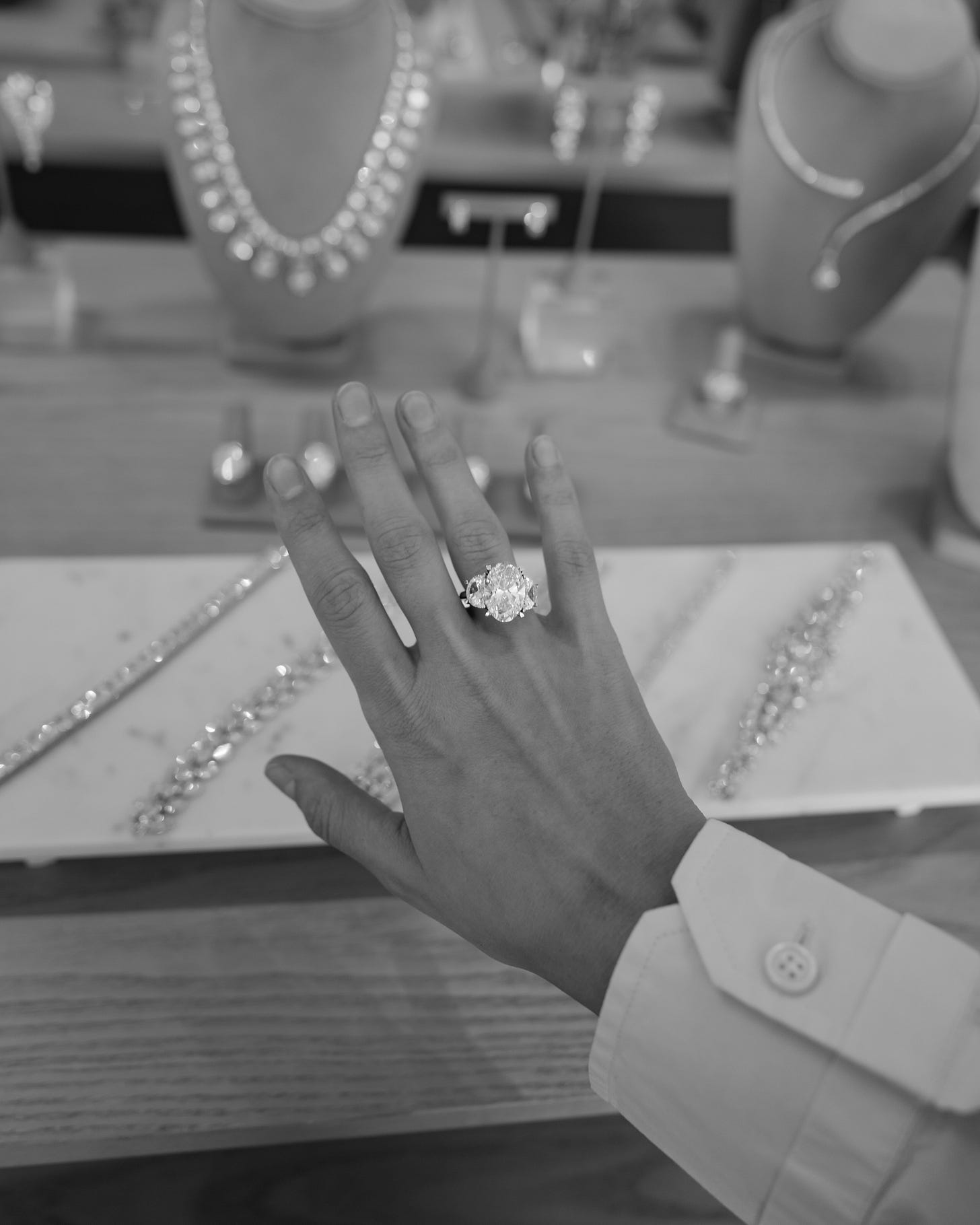If I'm doomed to the game, can I at least play it in peace? That’s the title of a sharp essay by
, a reflection on the personal right to engage with fashion (flawed, commodified, and endlessly co-opted) on one’s own terms. She challenges the policing of consumption, rejecting both the condescension of no-buy purists and the deception of brands masquerading as ethical.Fashion, she argues, is not the enemy; the system is. She defends the freedom to enjoy fashion as a form of self-expression, exploration, and even rebellion, without being shamed for it.
The essay is a call for nuance: to embrace both the frivolity and depth, to allow some space for occasional contradictions and impulses. A game played with eyes wide open, fully aware of its illusions but unwilling to surrender its small, defiant joys.
Her stance on fashion mirrors my own conflicted feelings about jewelry, particularly the debate between diamonds, natural and synthetic.
For most of my life, I was on the mined side. Growing up on an island in Brazil, I developed a reverential connection to nature. The raw beauty of the land and sea shaped my understanding of beauty, and for a while, a diamond's allure was inseparable from its genesis.
While not against synthetic, I wasn’t compelled by it.
Yet, recently, I found myself drawn to two brands, Dorsey and Grown Brilliance, both specializing in synthetic diamonds. It unsettled me. It wasn’t just a change in preference but a disruption of my own comfortable beliefs.
So, I laid out my (current) thoughts.
How’s the mined diamond market?
It is a complicated space where the undeniable beauty of natural stones is intertwined with ethical and environmental concerns.
The Kimberley Process was created in 2003 to stop diamonds from funding armed conflicts. While crucial in its initial aim, it has long been criticized for its limited scope, focusing narrowly on rebel-controlled diamonds and neglecting other ethical concerns. Meanwhile, the industry has moved ahead with more robust initiatives, like the Responsible Jewellery Council and Watch & Jewellery Initiative 2030.
At the heart of this market lies De Beers, the South African-British diamond conglomerate. Though its once-dominant market share, reaching up to 90% of rough diamond sales, has receded to 34.5% by value in 2021, reflecting increased competition and market diversification.
The company is synonymous with the diamond industry itself, largely due to its iconic Diamonds Are Forever campaign. By framing diamonds as a necessary emotional investment, it shifted the focus from monetary value to a symbol of eternal love. Before the 1930s, diamond rings were not the standard for engagements. Beyond the iconic slogan, De Beers also effectively manufactured demand through the two months’ salary rule, suggesting a tangible measure of commitment.
Lately, my curiosity about De Beers’ DiamondProof device was piqued by influencer-sponsored content:
(Consider Yourself Cultured) and fashion personality Kate Bartlett both spotlighted its retail applications. Launched last year at JCK Las Vegas with a $9,500 price tag and now appearing in stores, it’s positioned as a consumer-facing tool to swiftly differentiate natural diamonds from synthetic and simulants (claiming 100% accuracy).Its launch aligns with De Beers’ strategic retreat from synthetic diamond jewelry. CEO Al Cook has been vocal about the diminishing long-term value of lab-grown stones in the emotional purchase market, arguing that as their prices continue to drop, they’ll lose their significance. Instead, De Beers is steering synthetics toward high-value industrial applications.
And yet, De Beers wasn’t always so dismissive. Years ago, it introduced Lightbox, its own synthetic diamond brand—one that now appears headed for a quiet phase-out.
What remains unclear is how DiamondProof stacks up against existing detection methods, other than being more user-friendly. Meanwhile, De Beers’ reliance on influencer marketing suggests a calculated effort to reinforce the perceived value gap between mined and lab-grown diamonds.
It seems to me that the emphasis on immediate identification, while valuable, may divert attention from the more fundamental challenge of comprehensive traceability.
Then there's the paradox of resale value. We're told natural diamonds retain their worth, a testament to their enduring appeal. Yet, if diamonds are truly meant to symbolize eternity, isn't the very notion of resale a strange, transactional contradiction? A quiet betrayal of the forever narrative?
A communication issue
Ironically, of all replications, diamonds present a poetic twist. Once symbols of geological rarity and time's artistry, gems are now synthesized with near-identical composition. Yet, the industry avoids the term synthetic, using alternatives like lab-grown, cultured, or eco-friendly instead. This choice reveals a deeper anxiety about value in an era of engineered authenticity.
I do prefer the term synthetic: it speaks to origin, a fundamentally different process. Avoiding it with softer terms is linguistic sleight of hand. Lab-grown sounds like it was created in a hydroponic garden. Cultured, borrowed from pearls, suggests an organic collaboration. Eco-friendly and conflict-free tap into ethical consumerism, implying moral superiority, though both diamond types have complex ethical and environmental realities.
This linguistic dance prioritizes the art of persuasion over clarity.
As Paul Zimnisky, an industry analyst, points out, the aggressive promotion of lab-grown diamonds is contributing to a deflation of the entire diamond market. The very ease with which these stones are now created, their mass production at minimal cost is eroding the perception of rarity, impacting the value of their natural counterparts. He argues that conflating these distinct origins undermines the very foundation of the fine jewelry market, urging a clear separation to preserve the integrity of natural diamonds.
Ultimately, both sides of this diamond equation, mined and synthetic, must confront a deeper question: What is the true essence of value? Is it rooted in origin, in nature's processes, or human ingenuity to create and refine?
The marketing department is so tired.
Talk of the town
Recently, I opened a long-term Google Form inviting people to share their frustrations with jewelry. The response was overwhelming. While the content will remain private, my way of saying thank you is to break down some of these issues.
The excitement around synthetic diamond jewelry is real—contemporary designs, accessible pricing, and strong branding keep people engaged. The most-mentioned brands: Vrai, Grown Brilliance, and Dorsey.
For both mined and synthetic, a significant undercurrent of concern emerged: a disconnect between design and execution. Reports of loose stones, finish inconsistencies, and tarnishing were common. Add slow customer service and frustrating repairs, and there’s clearly work to be done.
Consumers, now better-versed in gemstone origins, refuse to compromise on the foundational standards of fine jewelry. Choosing synthetic diamonds is well accepted. To sustain trust and long-term growth, brands must tighten quality control and refine customer service.
I want to point out something important: companies that market synthetic diamonds often target women as buyers—and, notably, they are often women-led. The broader jewelry market, especially for natural diamonds, remains predominantly male, conservative, and old-fashioned, marked by gatekeeping and secrecy. Maybe the conversation should be more about that.
Closing remarks
Choosing between a natural and a lab-grown diamond comes down to priorities: emotional significance and budget.
Start by clarifying what matters most.
Factor in budget constraints, as lab-grown diamonds typically offer larger, higher-quality stones for the same price. Consider resale value: while natural diamonds generally retain a portion of their worth, synthetic ones depreciate even faster. If sustainability weighs on your mind, consider the trade-offs between mining impact and lab energy consumption.
Beyond the stone itself, craftsmanship, setting quality, and the jeweler’s reputation matter just as much.
Both have pros and cons. Prioritize well-made jewelry, especially from independent brands, and, when possible, build a personal relationship with the maker. Natural or synthetic, choose a piece that fits your budget and moves you.
One can own both synthetic and mined diamonds if one wants.
Thank you for reading, and enjoy your week!
Signing off with love,
Ísis






If the story is what gives a diamond its value, whose story are we really buying into: ours, or the industry's?
And what are your thoughts on De Beer discontinuing synthetic diamonds?
👋